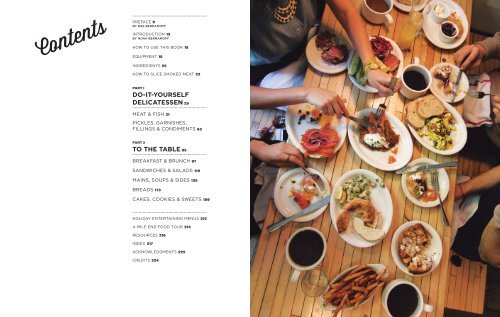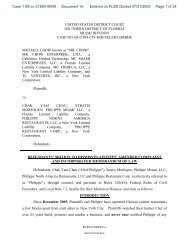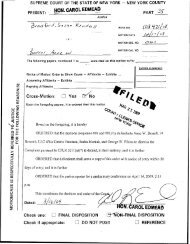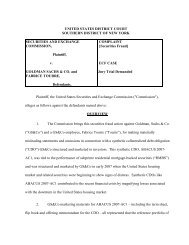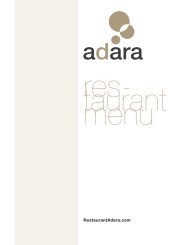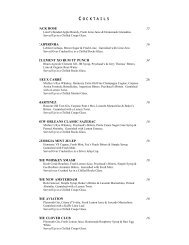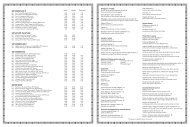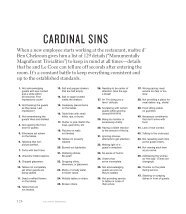Create successful ePaper yourself
Turn your PDF publications into a flip-book with our unique Google optimized e-Paper software.
Preface 9<br />
by Rae Bernamoff<br />
Introduction 13<br />
by Noah Bernamoff<br />
How to Use This Book 18<br />
Equipment 18<br />
Ingredients 22<br />
How to Slice smoked meat 23<br />
PART 1<br />
Do-It-Yourself<br />
Delicatessen 25<br />
Meat & Fish 31<br />
Pickles, Garnishes,<br />
Fillings & Condiments 63<br />
PART 2<br />
To the Table 95<br />
Breakfast & Brunch 97<br />
Sandwiches & Salads 119<br />
Mains, Soups & Sides 135<br />
Breads 173<br />
Cakes, Cookies & Sweets 189<br />
Holiday Entertaining Menus 212<br />
A <strong>Mile</strong> end Food Tour 214<br />
resources 216<br />
Index 217<br />
Acknowledgments 222<br />
Credits 224<br />
Cyan Magenta Yellow Black Pages:7 14126 • 21203234
56 THE MILE END COOKBOOK<br />
Lox<br />
Noah: We use this salt-cured salmon recipe for two of our signature<br />
breakfast dishes, the Beauty (page 98) and the Mish-Mash (page 109),<br />
but it’s great for all sorts of other preparations.<br />
Curing salmon is all about the fat. We use king salmon for making<br />
lox at the deli, and always the farmed variety, not wild. That’s because<br />
wild salmon tends to be too lean for curing. Too little fat will cause the<br />
salt mixture to “burn” the surface of the salmon and stop the cure from<br />
penetrating. Allowing the fillet to rest for a day after rinsing off the curing<br />
mixture enables the fish to continue “cooking"—that is, it lets the curing<br />
compounds distribute themselves evenly throughout the salmon. Using<br />
good kosher salt for this recipe is absolutely essential.<br />
cup whole black peppercorns<br />
cup sugar<br />
1 cup Diamond Crystal kosher salt<br />
1 bunch of dill<br />
1 2-pound boneless king salmon fillet, with skin<br />
Combine the peppercorns, sugar, and salt in a bowl and stir to combine. Place 2 or 3 sprigs of<br />
the dill in the bottom of a nonreactive baking dish, and sprinkle about ¼ cup of the salt mixture<br />
evenly over the bottom of the dish.<br />
Make 2 or 3 shallow cuts in the skin of the salmon fillet. Place the salmon, skin side down, on<br />
top of the salt and dill, and place a few more sprigs of dill on top of the salmon. Sprinkle<br />
the salmon all over with another ¼ cup of the salt mixture. Reserve the remaining salt mixture.<br />
Loosely cover the baking dish with plastic wrap and refrigerate it overnight.<br />
Carefully pour off any liquid that has accumulated in the baking dish. Add another ¼ cup of<br />
the salt mixture to the bottom of the dish, and sprinkle ¼ cup more over the salmon. Replace<br />
the dill sprigs with new ones if they’ve wilted. Cover the dish and refrigerate overnight.<br />
Repeat this process 2 more times over 2 more days.<br />
On the fifth day, remove the salmon, rinse it thoroughly, and pat it dry with paper towels. Place<br />
the salmon on a small drying rack set inside a clean baking dish or over a couple of layers of<br />
paper towels. Refrigerate, uncovered, overnight.<br />
To serve, slice very thinly and carefully at a shallow angle, working from the front of the fillet<br />
toward the tail.<br />
MAKES ABOUT 1½ POUNDS
Matzo<br />
Rae: You’d think more people would make their own matzo instead of<br />
buying it in a box—the recipe couldn’t be simpler, and come on, it’s the<br />
star of the Passover story. I use our homemade matzo instead of crackers<br />
all the time for snacks and hors d’oeuvres. How many pieces of matzo<br />
you get from this recipe will depend on how practiced you are at rolling<br />
and trimming the dough.<br />
4¼ cups sifted all-purpose flour, plus more as needed<br />
1 teaspoon Diamond Crystal kosher salt, plus more to top the matzo (optional)<br />
2 tablespoons canola oil<br />
¾ cup plus 1 tablespoon warm water<br />
Preheat the oven to 500°F and place a pizza stone (ideally) or a 10-by-15-inch baking sheet on<br />
the bottom rack.<br />
In a large bowl, mix together all the ingredients until they come together to form a dough.<br />
If the dough is sticky, add a bit more f lour.<br />
Divide the dough into 8 pieces. Flatten a piece slightly and pass it repeatedly through a pasta<br />
maker, reducing the thickness each time until you reach the minimum setting. (Or you can simply<br />
roll the dough as thinly as possible with a rolling pin.) Repeat with the remaining dough pieces.<br />
Trim the f lattened dough pieces so that they will fit snugly onto the pizza stone or baking sheet.<br />
Use a fork to prick holes in the surface of the dough. For salted matzo, brush or spray the dough<br />
surface lightly with water and sprinkle with salt.<br />
Carefully slide the pieces of dough onto the pizza stone or baking sheet. Bake until the surface<br />
of the matzo is golden brown and bubbly, 30 seconds or so. Using tongs, carefully f lip the matzo<br />
pieces and continue to bake until the other side is browned and lightly blistered. (Keep careful,<br />
constant watch to keep the matzo from burning; the exact cooking time will vary from oven to<br />
oven, and will get a little longer with each subsequent batch.)<br />
Makes about 8 large sheets<br />
breads<br />
187


